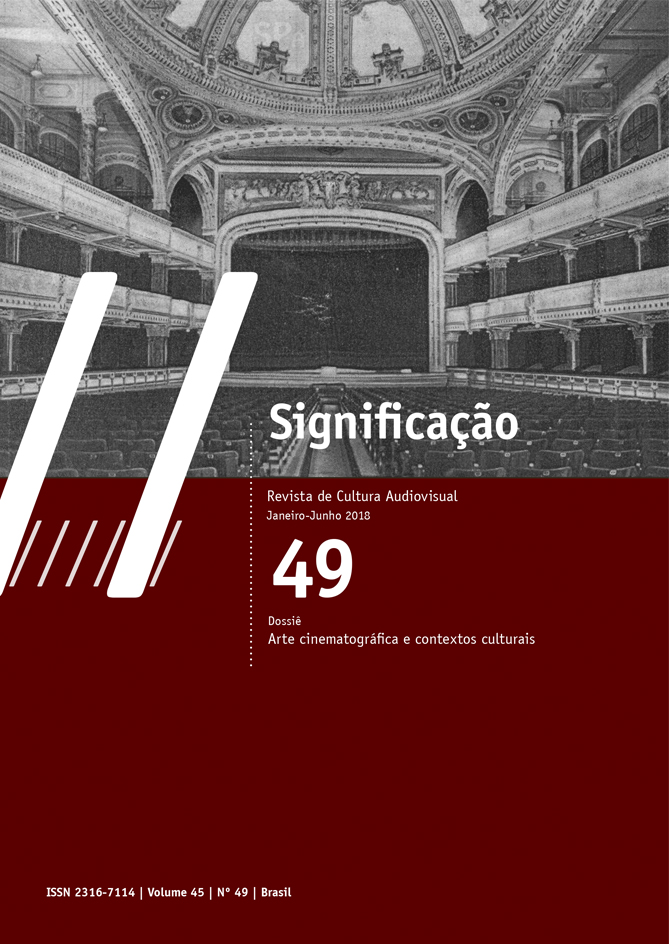The forms of materiality: frame, scale and affect in Ramsay’s cinema
DOI:
https://doi.org/10.11606/issn.2316-7114.sig.2018.137394Keywords:
Lynne Ramsay, materiality, affectAbstract
This article examines the relationship between narratives of minimum causality and the construction of spaces and framing of bodies and landscapes in Lynne Ramsay’s first two feature-length films, Ratcatcher (1999) and Morvern Callar (2002). It analyzes how the films portray the effects of trauma with aesthetic strategies that prioritizes the unconventional use of scale and movement. Hence, the analysis suggests that Ramsay’s aesthetic choices in depicting minimalist narratives create affective landscapes from the sensorial and embodied experience of the films. It contends that these films favor an aesthetic dimension of everyday details and intimacy, thus allowing the materialization of affect and revealing its poetic and politic force.
Downloads
References
AUMONT, J. Du visage au cinéma. Paris: Edition de L’Etoile/Cahiers du Cinéma, 1992.
BOGUE, R. Deleuze on cinema. New York; London: Routledge, 2003.
BRUNO, G. Surface: matters of aesthetics, materiality and media. Chicago: University of Chicago Press, 2014.
CREATIVE Scotland. Review of the film sector in Scotland. 2014. Disponível em: bit.ly/2FTcIgQ. Acesso em: 29 jun. 2017.
DELEUZE, G. Cinema 1: the movement-image. Minneapolis: University of Minnesota Press, 1986.
______. Cinema 2: the time-image. Minneapolis: University of Minnesota Press, 1989.
DELEUZE, G; GUATTARI, F. Kafka: por uma literatura menor. Rio de Janeiro: Imago, 1977.
DOANE, M. A. The close-up: scale and detail in the cinema. Differences: A Journal of Feminist Cultural Studies, Durham, v. 14, n. 3, p. 89-111, 2003.
FATORELLI, A. Imagem e afecção. Galáxia, São Paulo, n. 23, p. 48-58, 2012.
FISHER, A. Photographic scale. Philosophy of Photography, [S.l.], v. 3, n. 2, p. 310-329, 2012.
HJORT, M. Small nation, global cinema: the new Danish cinema. Minneapolis: University of Minnesota Press, 2005.
KENDALL, T. “The in-between of things”: intermediality in Ratcatcher. New Review of Film and Television Studies, Abingdon, v. 8, n. 2, p. 179-197, 2010.
KING, A. Fault lines: Deleuze, cinema, and the ethical landscape. In: CHOI, J.; FREY, M. (Org.) Cine-ethics: ethical dimensions of film theory, practice, and spectatorship. London; New York: Routledge, 2014. p. 57-75.
LEFEBVRE, M. Between setting and landscape in the cinema. In: ______. (Ed.) Landscape and film. London; New York: Routledge, 2006. p. 19-59.
MACHADO, R. Deleuze, a arte e a filosofia. 2. ed. Rio de Janeiro: Zahar, 2009.
MARKS, L. The skin of film: intercultural cinema, embodiment and the senses. Durham; London: Duke University Press, 2000.
MARTIN-JONES, D. Scotland: global cinema: genres, modes and identities. Edinburgh: Edinburgh University Press, 2009.
MASSUMI, B. Parables of the virtual: movement, affect, sensation. Durham; London: Duke University Press, 2002.
MAZIS, G. Merleau-Ponty and the face of the world: silence, ethics, imagination and poetic ontology. New York: Suny Press, 2016.
NATIONAL RECORDS OF SCOTLAND. Scotland’s population: the Registrar General’s Annual Review of Demographic Trends 2016. 2017. 123 p. Disponível em: bit.ly/2Hy94Gu. Acesso em: 22 nov. 2017.
RODOWICK, D. N. Gille Deleuze’s time machine. Durham; London: Duke University Press, 1997.
RUTHERFORD, A. Film, trauma and the enunciative present. In: ATKINSON, M.; RICHARDSON, M. (Ed.) Traumatic affect. Cambridge: Cambridge Scholars Publishing, 2013. p. 80-128.
Referências audiovisuais
MORVERN Callar. Lynne Ramsay, Reino Unido; Canadá, 2002.
RATCATCHER. Lynne Ramsay, Reino Unido; França, 1999.
Downloads
Published
Issue
Section
License
Copyright (c) 2018 Mariana Cunha

This work is licensed under a Creative Commons Attribution-NonCommercial 4.0 International License.
Authors who publish in this journal must agree with the following terms:
- Authors keep their copyrights and grant the journal first time publication rights, having their articles simultaneously licensed under the Creative Commons Attribution License, which allows sharing texts with authorship recognition and first publication on this journal for non-commercial purposes.
- Authors are allowed to make additional contracts, for a non-exclusive distribution of the article’s version published on this journal (e.g.: publishing in institutional repositories of articles or as a book chapter), with authorship recognition and first publication on this journal.
















